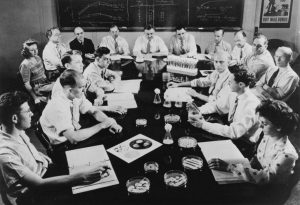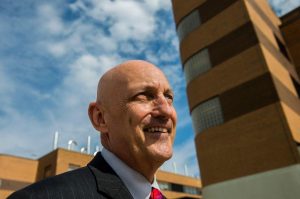BICENTENNIAL 2018: For more than 75 years, Peoria’s Ag Lab has made an impact on lives with ‘wonderful discoveries’
By Scott Hilyard — June 22, 2018
The USDA’s penicillin research team, which included microbiologists, chemists and fungi experts, gathers in Peoria in June 1944. (Source: United States Department of Agriculture)
The U.S. Department of Agriculture’s National Center for Agricultural Utilization Research, formerly named the Northern Regional Research Laboratory, has been headquartered in Peoria for 78 years.
Wait, the what?
Well, it’s best known as The Ag Lab, the federal scientific research operation that is the work home of 80 Ph.D. scientists and 120 support staff. Wrapped in post-9/11 wrought iron security, the building has been a solid, if vaguely mysterious, presence at the corner of Nebraska Avenue and University Street since 1940.
Created under the Agricultural Adjustment Act of 1938, The Ag Lab was one of four regional research centers built. Each center cost about $1 million each to build, equip and staff.
Then, the United States was emerging from the Depression and World War II was on the horizon. “All across this country there were large stockpiles of excess agricultural commodities,” former Ag Lab director Paul Sebesta said in 2015. “The chore was to take those excess commodities and create value-added products out of them to support the rural economy. The four centers were located in Peoria, close to the Great Lakes, in Philadelphia, one was located in New Orleans and one was located out on the West Coast, in the Bay Area. Each still exists and all four were constructed exactly the same.
“They were all in the shape of a ‘U,’ where they had two science wings. And perpendicular to the two science wings was the administration wing. We received additional money in the 1960s to add a third (science) wing onto our building. So we are the largest of the four regional research centers, both in terms of square footage, in terms of human capital and in terms of budget.”
Why Peoria?
The two commodities the Peoria center was to work on were corn and wheat. The reason was because of the Hiram Walker Distilleries, Peoria was the whiskey capital of the world, so the first research initiatives were to improve fermentation technologies. “It was because of the industry that was here and because of the agriculture commodities that were here and because of its close proximity to the Great Lakes. This was in the heart of agriculture territory,” Sebesta said.
The Peoria Ag Lab earned it’s first fame from penicillin.
Alexander Fleming had discovered penicillin in Britain. England was fighting the Germans before the United States joined World War II and was being bombed regularly and couldn’t build the laboratory to produce the penicillin. Britain contacted the USDA, and USDA knew of Peoria’s fermentation technologies. The British knew the value of penicillin and so they brought scientists and the penicillin strain to Peoria. They started doing research.

Paul Sebesta, former director of the U.S. Department of Agriculture’s National Center for Agricultural Utilization Research in Peoria, sees a bright future for continued innovation. (Journal Star photo)
“The original penicillin strain could not be cultured in large amounts,” Sebesta said. “They had to do a worldwide search for penicillin cultures, so Army Air Corps pilots were instructed that anywhere they landed, anywhere in the world on a dirt field, they were to scoop up a sample of dirt and send it to Peoria. And we evaluated all those samples for penicillin trying to find samples of penicillin that would grow rapidly because we knew that we needed huge doses of it, and it was hard to grow in the standard culture. It was purely by luck that a lady brought in a cantaloupe to the lab and there was a strain on there that could be rapidly cultured. The townspeople knew about the search (for penicillin cultures) and this woman, whose name was lost to history, got a moldy cantaloupe out of a Peoria grocery store.”
What did the scientists do with the moldy cantaloupe? That’s where scientist Andrew Moyer gets involved. They mutated the strain so it would grow faster and then developed the tanks and the medium onto which it would grow, and that happened to be corn steep liquor from the fermentation production of ethanol.
By June 1944, in times for the D-Day invasion, there was suitable quantities of penicillin to support the Normandy Invasion.
The Ag Lab touches the world in countless ways; Huggies diapers and Depends garments, for instance. The super-absorbent starch material that is in those diapers and those types of products that absorb liquid were developed in Peoria. It’s also used in operating rooms, anywhere you need to soak up large amounts of fluid because it can soak up to 1,000 times its weight in moisture.
Add Sebesta, “Another product that was developed is something that you eat every day if you have a salad, but don’t know it. The product that is in every salad dressing is xantham gum and that came from this lab as well. There’s another product that came from this lab that supported the Korean War effort and that’s called dextran, a plasma extender that adds volume to plasma.”
The Ag Lab also has one of the largest publicly available collections of microbes in the world. That’s about 90,000 different microbes — yeasts, bacteria, fungi, etc. — that started from the penicillin work.
“If you want a microbe to do something specific you can access this culture collection to screen the microbes in there to find microbes that will make products for you in the fermentation. We make these microbes available free of charge to any scientific organization or scientist around the world,” said Sebesta.
What does the future look like for the Ag Lab?
“We’re not going to run out of people’s problems to solve so we better have very good solutions to those problems,” Sebesta said in 2015. “One of the things I like to say is that when you are a scientist you have a career of discovery. All of the scientists and support staff in this building are dedicated and working hard to improve the lives of Americans. Every day when I come into this building and come up the front steps I put my hand on that door and I think, ‘I wonder what wonderful discoveries are we going to make here today.’ Because that’s what we do. Think about what a wonderful career that is, to work every day of your life trying to discover something.”
Portions of this article appeared in the Journal Star in 2015. Scott Hilyard can be reached at shilyard@pjstar.com. Follow @scotthilyard on Twitter.
Editor’s note: The weekly Illinois Bicentennial series is brought to you by the Illinois Associated Press Media Editors and Illinois Press Association. More than 20 newspapers are creating stories about the state’s history, places and key moments in advance of the Bicentennial on Dec. 3, 2018. Stories published up to this date can be found at 200illinois.com.
–BICENTENNIAL 2018: For more than 75 years, Peoria’s Ag Lab has made an impact on lives with ‘wonderful discoveries’–







